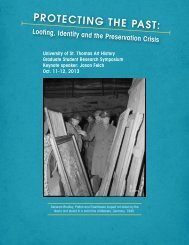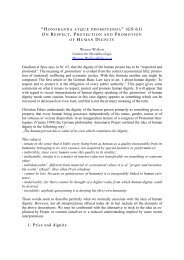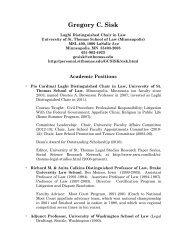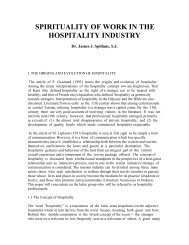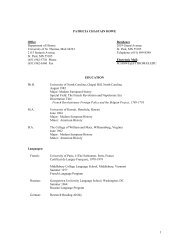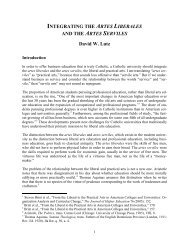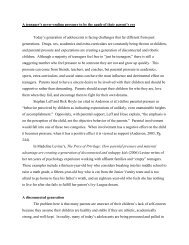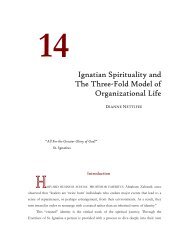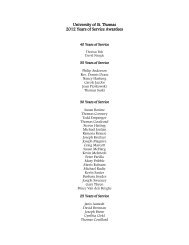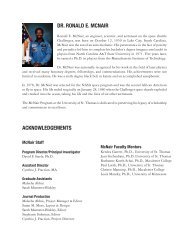McNair Research Journal - University of St. Thomas
McNair Research Journal - University of St. Thomas
McNair Research Journal - University of St. Thomas
You also want an ePaper? Increase the reach of your titles
YUMPU automatically turns print PDFs into web optimized ePapers that Google loves.
Humanities & Social Sciences<br />
Propinquity/Homophily<br />
Propinquity is defined as the tendency for people to form relationships<br />
with one another based on their proximity to one another, where as<br />
homophily is defined as the tendency for people to form relationships<br />
with others who are similar to themselves (Mouw & Entwisle, 2006). In<br />
relation to interracial friendships, past research has uncovered that living<br />
in an integrated neighborhood, attending an integrated school and living<br />
in a metropolitan area influences one’s likelihood to engage in interracial<br />
friendships (Antonio, 2004; Emerson, Kimbro & Yancey, 2002; Mouw &<br />
Entwisle, 2006; Sigelman & Welch, 1993; Way & Chen, 2000). On the<br />
other hand, additional research has uncovered that when students attend a<br />
school where there is not a clear racial majority they are less likely to<br />
befriend a person from a different racial or ethnic group, increasing the<br />
likelihood <strong>of</strong> a racially homogenous groups <strong>of</strong> friends (Way & Chen, 2000).<br />
In regards to interracial dating and marriage, past research has uncovered<br />
near identical findings as interracial friendships. Suggesting that living in<br />
an integrated neighborhood, attending an integrated school and living in<br />
a metropolitan area influences one’s likelihood to date or marry someone<br />
from a different racial group (Jacobson & Johnson, 2006; Yancey, 1998).<br />
However, the findings for interracial dating and marriage are not as well<br />
supported as the findings for interracial friendships. This discrepancy<br />
may be due to the greater degree <strong>of</strong> commitment in dating and marriage<br />
relationships.<br />
As mentioned earlier, interracial marriages among Asian-Americans are<br />
gradually declining while interethnic marriages are increasing (Lee &<br />
Fernandez, 1998). This gradual shift may be attributed to the growing<br />
population <strong>of</strong> Asian-Americans within the United <strong>St</strong>ates. In other words,<br />
because <strong>of</strong> the growing populations <strong>of</strong> multiple Asian ethnic groups,<br />
Asian-Americans are presented with a greater opportunity to find suitable<br />
mates within their own race.<br />
Socioeconomic <strong>St</strong>atus (SES)/Educational Attainment<br />
In terms <strong>of</strong> SES and educational attainment, previous studies have<br />
uncovered that well-educated, high-SES respondents are likely to approve<br />
<strong>of</strong> interracial marriages (Jacobson & Johnson, 2006; Yancey, 1998).<br />
Specifically in relation to Asian-Americans, high-SES Asians are more<br />
likely to date Whites when compared with their low-SES counterparts<br />
who are more likely to date Hispanics and Blacks (Wang & Kao, 2007).<br />
It is possible that high-SES Asians are able to afford to live in affluent<br />
neighborhoods and send their children to private schools where there may<br />
be limited racial and ethnic diversity.<br />
Gender<br />
Past research focusing on gender differences reveal that males not only<br />
have a greater level <strong>of</strong> acceptance toward interracial romantic relationships<br />
than females, but also are more likely to have dated someone from a<br />
different racial background (Jacobson & Johnson, 2006; Yancey, 1998).<br />
However, this finding fails to hold true for Asian-American men, possibly<br />
because Asian-American parents are generally stricter when it comes to<br />
dating, essentially creating a socially awkward situation for their sons since<br />
men are the ones who generally initiate the majority <strong>of</strong> dates within the<br />
U.S. mainstream society.<br />
Age<br />
Past research suggests that aging reduces the racial diversity <strong>of</strong> an<br />
individual’s circle <strong>of</strong> friends while also reducing the frequency <strong>of</strong> interracial<br />
romantic relationships. (Emerson, Kimbro & Yancey, 2002; Jacobson<br />
& Johnson, 2006; Joyner & Kao, 2005; Yancey, 1998). One possible<br />
explanation for this trend suggests that as people age, they make the transition<br />
to adulthood by considering the prospect <strong>of</strong> marriage and in doing<br />
so they may develop a preference toward intraracial marriage rather than<br />
interracial marriage. Another possible explanation for this trend could be<br />
<strong>University</strong> <strong>of</strong> <strong>St</strong>. <strong>Thomas</strong> <strong>McNair</strong> <strong>Research</strong> <strong>Journal</strong><br />
Amy S. Westmoreland<br />
Interracial Romantic Relationships<br />
based on the argument that many <strong>of</strong> the studies assessing age differences<br />
were conducted over a decade ago, when interracial contact was generally<br />
perceived as unacceptable. Based on this explanation, generational status<br />
would serve as the predictor variable rather than age.<br />
In sum, although previous research has paved the road for understanding<br />
interracial relations, many studies focus exclusively on the black/white<br />
paradigm. The present study will contribute to the current literature<br />
by examining Asian-American attitudes towards interracial romantic<br />
relationships. In addition, many studies assessing attitudes toward<br />
interracial romantic relationships are predominately based on quantitative<br />
methodologies. Therefore, in order to control for the limitations <strong>of</strong> past<br />
studies, the present study will contribute to the existing literature by<br />
incorporating qualitative methodologies based on a sample <strong>of</strong> Asian-<br />
American respondents.<br />
Conceptual Framework<br />
The present study is centered on three theories, the first being Bonilla-<br />
Silva’s stylistic components <strong>of</strong> color-blind racism (Bonilla-Silva, 2002).<br />
Color-blind racism is also known as contemporary racism whereby people<br />
claim to believe skin color should not be the basis <strong>of</strong> social judgment and<br />
that discrimination on the basis <strong>of</strong> race is the problem <strong>of</strong> the past. When<br />
color-blind racists are asked to engage in a conversation regarding race,<br />
they <strong>of</strong>ten employ the following five stylistic techniques:<br />
1.) White’s avoidance <strong>of</strong> direct racial language<br />
2.) The central rhetorical strategies or “semantic moves” used by whites to<br />
safely express their racial views<br />
3.) The role <strong>of</strong> projection<br />
4.) The role <strong>of</strong> diminutives<br />
5.) How incursions into forbidden issues produce almost total<br />
incoherence among many whites.<br />
The second theory is Gordon W. Allport’s social contact hypothesis or<br />
the notion that interaction between members <strong>of</strong> different racial groups<br />
can lead to positive racial attitudes (Allport, 1954). The four specific<br />
conditions under which interracial interaction should occur to result in a<br />
positive outcome consist <strong>of</strong> the following (Allport, 1954):<br />
1. Working towards common goals<br />
2. Intergroup cooperation<br />
3. Equal status<br />
4. Authority support<br />
The final theory included in the present study is the transracial adoption<br />
paradox which is the tendency for family and friends to treat transracial<br />
adoptees as if they were members <strong>of</strong> the dominant White society when in<br />
reality they are racial/ethnic minorities (Lee, 2003).<br />
Methodology Respondents<br />
A total <strong>of</strong> eight respondents (two males, six females) ranging in age from<br />
18 to 22 years old, = 19.6 years old have participated in the study.<br />
Respondents were recruited from a medium size Catholic liberal arts<br />
university consisting <strong>of</strong> over 6,000 undergraduate students with students<br />
<strong>of</strong> color consisting <strong>of</strong> 10 percent <strong>of</strong> the overall undergraduate and<br />
graduate student population.<br />
Respondents participated in the study by responding to informational<br />
signs in the undergraduate psychology department. Additional respondents<br />
were recruited by creating a snowball effect with existing contacts.<br />
As an incentive to participate in the study the respondent names were<br />
entered in a random drawing for a chance to win a $25 gift certificate for<br />
a local restaurant.<br />
61



